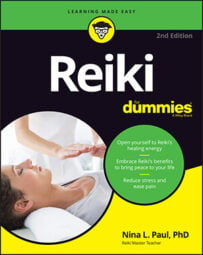What is Reiki?
The Reiki system of healing uses universal life-force energy. Reiki originated in Japan and was discovered by Mikao Usui in 1922. Usui Reiki has two main branches: Japanese and Western. Both forms include the same basic features, including those in the following list. Reiki is
- Safe: No one can do any harm with the Reiki energy.
- Intelligent: The energy knows where to go and what to do to help you.
- Natural: You need no other tools or instruments besides the Reiki practitioner, who channels the Reiki energy through their hands.
- Gentle: The practitioner places their hands softly on the body or just above it. Practitioners don’t use massage or manipulation.
- Simple to learn: You can learn Reiki in three classes: 1st degree, 2nd degree, and 3rd degree (Master level).
- Lifelong: After you’re attuned to the Reiki energy by studying one of the three degrees of Reiki, you can channel Reiki for life.
- Compatible with all religions or belief systems: You can receive or practice Reiki no matter what your religion. People of all faiths use Reiki as a way to relax and heal.
Components of the Reiki healing system
Reiki contains five central elements that the practitioner uses to prepare to channel Reiki energy and heal themselves and others. Go through this list when preparing to give or receive Reiki:
-
Attunements (initiations): Within a context of Reiki training, you are put “in tune” with the Reiki energy so that you have the life-long ability to channel the energy.
-
Hand positions: Use a set of positions to know where to place your hands during a Reiki session.
-
Self-Reiki hand positions: Use these positions to treat yourself with Reiki.
-
Treating others hand positions: Use these positions to treat other people with Reiki.
-
-
Meditation and focusing: Connect with the source of Reiki universal energy and concentrate the Reiki healing energy within yourself.
-
Symbols: Use the Reiki symbols and the sound of their name as a mantra to connect with Reiki energy.
-
Reiki Principles: The five principles of Reiki are used as the basis of a daily meditation practice.
The three levels of Reiki training
Reiki is easy to pick up, with only three levels of training to reach the level of Master. The following list describes the three levels. Keep these in mind when training or when looking for a Reiki practitioner:
-
1st degree: Also called Reiki I or Shoden in Japanese. This is entry-level Reiki training where you study Reiki history, learn how to perform self-Reiki, and how to give Reiki to someone else, and are initiated (attuned) for life to the Reiki energy.
-
2nd degree: Also called Reiki II or Okuden in Japanese. You learn how to use the first three Reiki symbols and how to perform distant Reiki techniques. You receive further attunements to the Reiki energy. After this class, you are considered a Reiki practitioner.
-
3rd degree: Also called Reiki III or Shinpiden in Japanese. This is the Master Teacher level of Reiki, and the class may be separated into two parts. You receive the Master Reiki attunement and learn the Master Reiki symbol and how to give the Reiki attunements to others.

